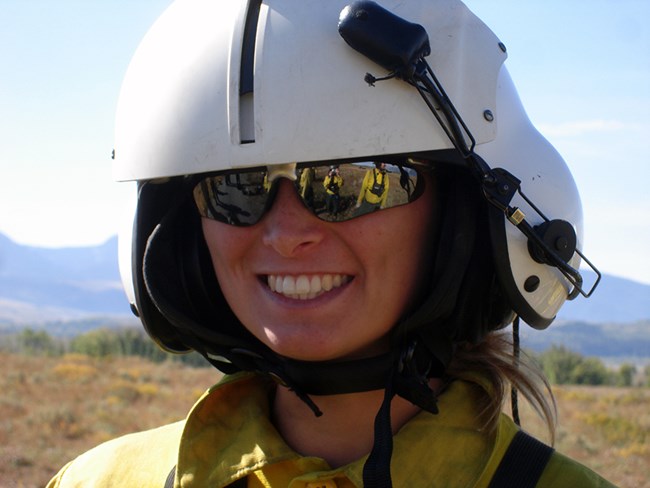Last updated: February 28, 2022
Article
Women in Fire Science: Cynthia Worthington

My fire science story sparked when I began my first field job studying the effects of fire on invasive plants in burned areas of Alaska, but it got established when I attended a career fair at Clemson University as a senior undergraduate student studying Conservation Biology. I talked to many professionals at the career fair, and there was only one person there who seemed genuinely enthusiastic and excited about his job. Wildland firefighter Alex Scronce was recruiting interns for Kings Mountain National Military Park’s fire program. Even though I was afraid of matches, I submitted an application and interviewed a few weeks later. I loved working outside, learning about the natural world, playing sports and helping my dad with construction work.
I worked at Kings Mountain National Military Park for six months, primarily running a chainsaw forty hours per week prepping burn units. I was very proud to be a female fresh out of college running a chainsaw and applying fire on the landscape for a living. The two other fire interns and I spent more than two months traveling the Southeast with the Great Smoky Mountains Fire Use Module (now called the Great Smoky Mountains Wildland Fire Module), assisting with prescribed burns at National Park Service units. When prepping for burns, we spent a lot of time moving logs away from the boundaries of our prescribed burn units, and it tickled me that I was applying skills and strengths that I had gained as a high school shot put and discus thrower. I also got a kick out of going back to college and having friends remark on my growing arm muscles. As the prescribed fire season came to a close, one of my fellow fire interns and I were invited to assist the Great Smoky Mountains Fire Effects Module. We traveled with the fire effects module to more southeastern national parks learning about and documenting the effects of prescribed burns within the parks. The work allowed us to quickly learn many plant species and signs of fire within fire-adapted ecosystems.
Traveling to national parks for work was a great learning and exploring experience. Before working in fire, I had only visited three national parks and I hadn’t realized that they were national parks at the time. I was captivated by the idea of traveling the country and exploring new natural areas and ecosystems on the job. During my next internship, I worked for the United States Geological Survey searching the Mojave Desert for rare plants. I couldn’t stop thinking about fire and how it would move across the desert landscape. I had caught the fire bug and I missed being a part of the fire community.
The following year, I was offered my first National Park Service seasonal position as a fire effects monitor at Grand Teton National Park. The Teton crew was an interagency traveling fire effects crew that worked on both National Park Service and United States Forest Service lands. We primarily surveyed vegetation plots within prescribed burns, but we also assisted with prescribed burns and responded to wildfires. Since fire affects all resources within a landscape, our crew collaborated with and assisted the park’s vegetation crew with monitoring and eradicating exotic plant species.

NPS
The importance of collaboration with other fields and the built-in adaptability of fire programs is one of my favorite parts of working in fire that keeps me coming back. I have a broad skillset and many interests that I am able to draw from and explore as a fire effects monitor and firefighter. The wildland fire community is small and close and we often rely on assistance and knowledge from other programs and agencies to conduct prescribed burns, contain wildfires and complete fire effects monitoring. The training that we receive in fire also prepares us to respond to national disasters like oil spills, hurricanes and large wildfires. I often respond to those disasters as a Resource Advisor drawing on my broad interests and background to help personnel minimize impacts to natural and cultural resources.

Should you choose a career in fire science or a similar field, don’t ever feel like you have to be one of the guys in order to succeed. Be yourself and ask for help when you need it. I recommend having close supportive friends in the fire world and outside the fire world who you can talk to and who can help put things into perspective when you encounter challenges. Always be assertive, stand up for yourself and be your best advocate.
Tags
- grand teton national park
- great smoky mountains national park
- kings mountain national military park
- natchez trace parkway
- fire science
- international day of women and girls in science
- fire ecology
- fire effects monitoring
- fire careers
- fire jobs
- women in science
- science
- meet the scientist
- nps careers
- women of the nps
- women in fire science
- in the field
- interns artists volunteers
- wildland fire
